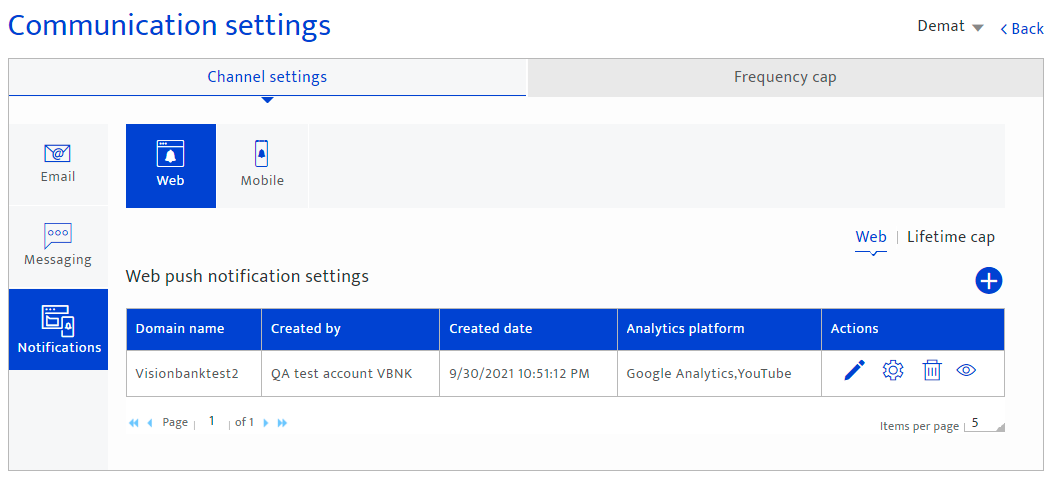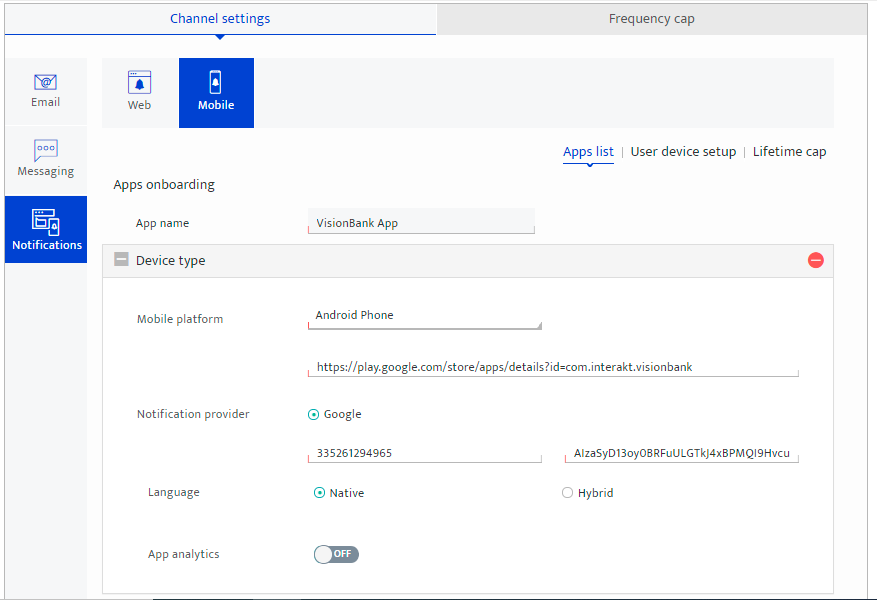Mobile domain settings iOS
Onboarding mobile to set mobile push notification delivery - iOS#
The two main activities to regulate the campaign communications through the mobile push notifications delivery channel are:
- Configuration settings to deliver the mobile push notification delivery messages
- Lifetime cap rules for push notification delivery
Configuring mobile push notification delivery:
Perform the listed steps to enable mobile push notification delivery:
Prerequisite: Access the application with authorized user credentials.- Navigate to Preferences in the main menu > Setup pane and select Communication settings.
- In the Channel settings tab, select Notifications on the left menu and Mobile on the top menu to enable mobile push notifications.
- Click the Add icon to add a new mobile push notification setting.
The App onboarding to set the Notifications for Mobile screen displays. - In the App onboarding for Mobile push notification settings, enter the following items:
App name - Enter the name of the mobile app to enable notifications for a mobile app.
Mobile platform - The mobile platform relates to the hand-held device type such as either a mobile or tab and related OS such as either Android or iOS. The device details are required to enable the mobile push notification settings.- Select the type of Mobile platform identified for analytics tracking. The Mobile platforms available are Android mobile, Android tab, iOS mobile-iPhone, and iPad.
- FCM Sender – Enter the Firebase cloud messaging (FCM) sender ID.
- FCM Server key – The Firebase cloud messaging server authentication identifier (ID) forms the FCM Server key.
- Enter the FCM Server key.
- Native - Confirm whether the mobile app is native.
A native mobile app is a smartphone application coded in a specific programming language, such as Java for Android or Objective C for iOS operating systems. - Hybrid – Confirm whether the mobile app is a hybrid app.
The hybrid smartphone application has cross-platform compatibility but can still access a phone’s hardware. The hybrid application use platforms such as PhoneGap and others. - To retain the settings defined, click Save or Cancel to exit the activity.
- Optional: There is an additional Add icon to add a new mobile device type to set the push notification setting.
Refer to the image below, the Mobile push notification settings - List view displays.


AppStore URL - Enter the AppStore link for activating tracking for a brand.
Note
For Android platform – Provide the related link for the Android app, which displays at Google Play Store or Windows store.
Google Play Store and Windows Store are the major app store for Android apps.
For iOS platform – Provide the related link for iOS app which displays in Apple App Store.
Notification provider - For Android platform: By default, the Google platform displays.
Note
Understanding the FCM Sender ID - A unique numerical value gets generated while creating the Firebase project in the 'Cloud Messaging' tab of the 'Firebase console – Settings' pane. Use the sender ID to identify each sender that can send messages to the client app.
Understanding the FCM Server key - Use the FCM Server Key to send Android mobile/tab app devices push notifications. Consider the server key for use as the remainder of API calls on the server-side.
Reference - For more information on FCM sender ID, refer to the Firebase developer console and the ‘Cloud messaging’ pane to get the FCM Sender ID and the FCM Server key.
Language
App analytics - Select the toggle switch On/Off to indicate whether app-level analytics needs to be enabled or not.